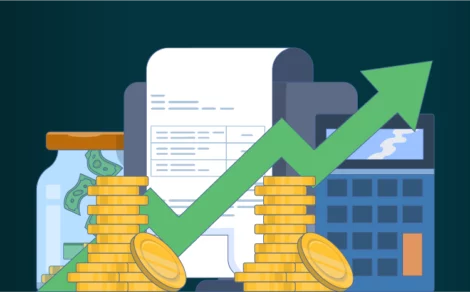A savings account is among the safest means of holding and accumulating money. However, many account holders are unaware of how interest is calculated, which can impact their financial planning. Understanding how savings interest works helps you maximise your earnings and make informed financial decisions.
In this blog, we will break down the process of calculating interest on a savings account, explore the key factors that influence it, and share tips to boost your savings effortlessly.
Understanding Interest on a Savings Account
Interest on a savings account is the money a bank pays you for keeping your funds deposited with them. It serves as an incentive for saving while ensuring liquidity. The interest is typically expressed as an Annual Percentage Yield (APY) and depends on several factors, including the interest rate, compounding frequency, and account balance.
The Formula for Calculating Savings Interest
For calculating interest on a savings account, you need to understand the concept of simple and compound interest. Simple interest is calculated only on the initial deposit, while compound interest is earned on both the principal and accumulated interest, resulting in higher returns over time. Since most banks in India offer compound interest, your savings can grow faster compared to simple interest.
The basic savings account interest calculation formula depends on whether it follows simple interest or compound interest.
For simple interest, the formula is:
SI = P × r × t
Where:
- SI = Simple Interest
- P = Principal amount (initial deposit)
- r = Annual interest rate (as a decimal)
- t = Time period in years
For compound interest, the formula is:
A = P(1 + r/n)^(nt)
Where:
A = Final amount after interest
P = Principal amount
r = Annual interest rate (as a decimal)
n = Number of times interest is compounded per year
t = Number of years
Calculating Interest on a Savings Account
Understanding how to calculate interest on a savings account is essential for effective financial planning. Banks typically pay interest based on your daily balance and the applicable annual interest rate. Follow these steps to compute your earnings:
-
Step 1: Identify Key Factors
Collect the necessary details such as average daily balance, interest rate per annum, number of days in a month, and total number of days in a year (365 or 366 for leap years).
-
Step 2: Apply the Formula
The interest is determined with the following formula:
Interest = (Daily Balance × Number of Days × Interest Rate) / Days in a Year
-
Step 3: Do the Math
For example, if you have a balance of ₹8,00,000, an annual interest rate of 3.75%, and a 30-day period, the calculation would be:
Interest = (8,00,000 × 30 × 3.75/100) / 365
= ₹2,465.75
-
Step 4: Consider the Effect
To increase your earnings, consider maintaining a higher balance in your account and choose a bank that compounds interest more frequently.
Tips to Maximise Interest Earnings on a Savings Account
To maximise your savings account interest, consider these useful tips:
-
Opt for a High-Interest Savings Account
Banks pay varying interest rates. Being familiar with the interest rates on savings accounts of different banks will be helpful before opening an account.
-
Utilise Idle Funds Wisely
Banks provide sweep-in and sweep-out facilities, where excess funds are automatically transferred to a Fixed Deposit (FD), which gives a better interest rate. You can seamlessly sweep the funds into your savings account in case of an emergency.
-
Opt for Age-Based Savings Accounts
Special accounts for seniors usually yield better interest rates compared to regular accounts.
-
Use Mutual Funds
You can invest in mutual funds with Torus Digital to grow your money through professionally managed portfolios. While they come with some level of risk, they offer the potential for higher returns compared to traditional savings, making them a valuable investment option for long-term wealth creation.
-
Invest in Certificates of Deposits (CDs)
Certificates of Deposit (CDs) are similar to Fixed Deposits (FDs), offering a lock-in period ranging from three months to one year. By reinvesting matured CDs, you can maximise returns and generate a steady high-interest income over time.
Key Factors Influencing Savings Account Interest
Several factors influence how interest is calculated on a savings account and determine how much you earn over time. Here are the most important ones:
- Interest Rate: Higher interest rates mean higher earnings. Compare rates from different banks before opening an account to maximise returns.
- Compounding Frequency: The more frequently interest is compounded (like compounding per day or month), the faster your savings grow.
- Account Balance: Having a higher balance generates more interest, particularly on accounts with tiered interest rates.
- Additional Charges and Bank Policies: Always review the terms and conditions, as various banks have different policies and charges on interest payments, minimum balances, and withdrawal limits.
- Economic Conditions: Interest rates are influenced by central bank policies, inflation, and economic changes. Staying informed about financial trends can help you make smarter banking decisions.
Final Thoughts
Understanding the calculation of interest on savings accounts enables you to make smart investment choices and optimise gains. Whether through manual calculations, financial tools, or reviewing bank statements, tracking your interest helps with long-term financial planning.
To optimise your savings, choose a high-interest savings account, maintain a healthy balance, and take advantage of frequent compounding. Remain proactive, compare rates, and use smart saving tactics to gain maximum interest returns!
Leverage Torus Digital to explore a wide range of investment opportunities and grow your wealth efficiently!








